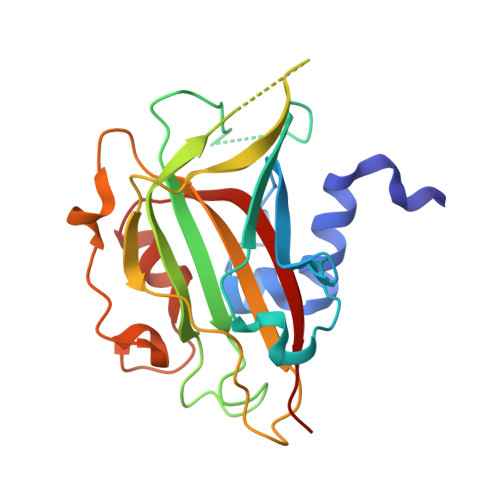Structure of the carboxypeptidase y inhibitor i(c) in complex with the cognate proteinase reveals a novel mode of the proteinase-protein inhibitor interaction
Mima, J., Hayashida, M., Fujii, T., Narita, Y., Hayashi, R., Ueda, M., Hata, Y.(2005) J Mol Biology 346: 1323-1334
- PubMed: 15713484
- DOI: https://doi.org/10.1016/j.jmb.2004.12.051
- Primary Citation of Related Structures:
1WPX - PubMed Abstract:
Carboxypeptidase Y (CPY) inhibitor, IC, shows no homology to any other known proteinase inhibitors and rather belongs to the phosphatidylethanolamine-binding protein (PEBP) family. We report here on the crystal structure of the IC-CPY complex at 2.7 A resolution. The structure of IC in the complex with CPY consists of one major beta-type domain and a N-terminal helical segment. The structure of the complex contains two binding sites of IC toward CPY, the N-terminal inhibitory reactive site (the primary CPY-binding site) and the secondary CPY-binding site, which interact with the S1 substrate-binding site of CPY and the hydrophobic surface flanked by the active site of the enzyme, respectively. It was also revealed that IC had the ligand-binding site, which is conserved among PEBPs and the putative binding site of the polar head group of phospholipid. The complex structure and analyses of IC mutants for inhibitory activity and the binding to CPY demonstrate that the N-terminal inhibitory reactive site is essential both for inhibitory function and the complex formation with CPY and that the binding of IC to CPY constitutes a novel mode of the proteinase-protein inhibitor interaction. The unique binding mode of IC toward the cognate proteinase provides insights into the inhibitory mechanism of PEBPs toward serine proteinases and into the specific biological functions of IC belonging to the PEBP family as well.
Organizational Affiliation:
Division of Applied Life Sciences, Graduate School of Agriculture, Kyoto University, Kyoto 606-8502, Japan.





















